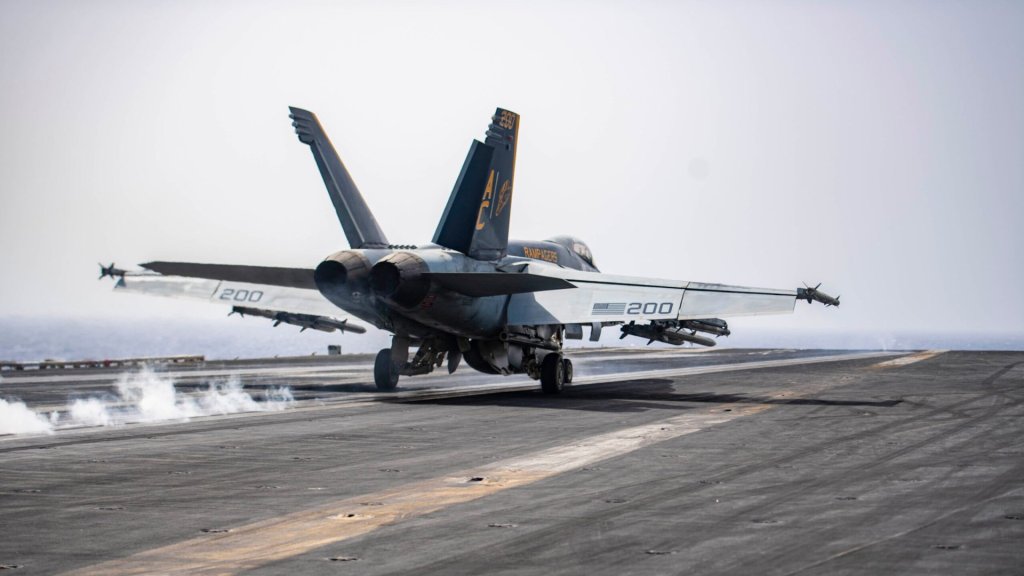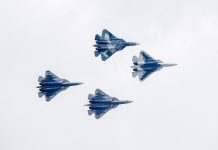The US Navy has officially coined the term “Murder Hornet” to refer to the F/A-18E/F Super Hornets equipped with a formidable combination of five AIM-120 Advanced Medium Range Air-to-Air Missiles (AMRAAMs) and four AIM-9X Sidewinders.
This powerful configuration, aimed at enhancing operational effectiveness, was among the key developments highlighted in the Navy’s 2024 year-in-review factsheet, first reported by The War Zone.
The factsheet also celebrated other milestones, including the formal introduction of the AIM-174B air-launched Standard Missile-6 (SM-6), the first combat use of the AGM-88E Advanced Anti-Radiation Guided Missile (AARGM), and the Navy’s inaugural air-to-air engagement with a hostile drone.
To accommodate the new loadout, the Navy had to clear the Super Hornets to carry AIM-9X Sidewinders on their outboard underwing stations, a capability previously limited to the wingtips.
This improvement was driven by urgent operational demands to counter the growing threat of kamikaze drones deployed by Iranian-backed Houthi militants in Yemen.
The “Murder Hornet” configuration was first observed in action during operations in the Red Sea region in April 2024.
F/A-18E/Fs flying from the USS Dwight D. Eisenhower were seen equipped with the advanced loadout alongside AN/ASQ-228 Advanced Targeting Forward-Looking Infrared (ATFLIR) targeting pods and centerline 480-gallon fuel tanks.
This setup has since been employed by Super Hornets, which operates from other carriers in the Middle East.
Last year, a senior US Navy officer disclosed that the upgraded loadout immediately increased firepower and capability, especially in the Red Sea, where operations have become increasingly critical.
This isn’t the Navy’s first experiment with heavier air-to-air loadouts. The term “Murder Hornet” has also been informally applied to an even more powerful configuration seen on an F/A-18F assigned to the Navy’s Air Test and Evaluation Squadron Nine (VX-9).
During Exercise Gray Flag 2024, the aircraft was equipped with four AIM-174Bs, three AIM-120s, and two AIM-9Xs. The introduction of the AIM-174B highlights the growing reliance on advanced air-to-air munitions.
Built on the Standard Missile 6 (SM-6) platform, the AIM-174B significantly extends the reach of modern fighter jets, surpassing the capabilities of older missiles like the AIM-120 and AIM-9.
For instance, while the AIM-120 can engage targets at ranges exceeding 30 miles, and the AIM-9 is limited to under 20 miles, the AIM-174B boasts a striking range of over 200 miles.
This improvement would allow US fighter jets to neutralize potential threats, such as Chinese aircraft, long before they enter the danger zone and offer a decisive advantage in aerial defense.
Why The US Navy Is Loading Up Its F/A-18s?
The US Navy has been increasingly pushing the capabilities of its F/A-18 fleet to enhance the effectiveness of these fourth-generation fighter jets in a rapidly evolving combat environment, one that is increasingly defined by the presence of drones and fifth-generation air capabilities.
For instance, last summer, the Navy equipped a F/A-18 Super Hornet with the AGM-158C LRASM, a long-range stealth anti-ship missile designed to neutralize Chinese surface combatants in potential Indo-Pacific conflicts.
This combination of older platforms with advanced munitions is a strategic approach to overcoming these aircraft’s limitations in a modern, fifth-generation airspace.
Equipping the F/A-18 Super Hornet with stealth weapons doesn’t turn it into a fifth-generation aircraft capable of directly confronting Chinese stealth fighters. Still, it greatly boosts its operational effectiveness and increases its chances of surviving in high-stakes, peer-level conflicts.
Simultaneously, the upgraded Sidewinder missile loadout on the Super Hornet—and the integration of the AIM-9X on the Navy’s EA-18G Growler—has broad applications in various other scenarios.

In particular, when combined with helmet-mounted cueing, the AIM-9X provides powerful close-range capabilities. These capabilities make it highly effective against an increasing number of drone threats, which are becoming a concern in many different theaters of operation.
As a result, the added flexibility of the upgraded Super Hornets and Growlers will likely be invaluable in scenarios beyond the Gulf of Aden.
Overall, as the threat landscape grows more complex, providing tactical fighter jets with greater missile capacity has become more critical—especially with the increasing proliferation of drones across various domains.
The US Air Force’s new F-15EX Eagle II is a clear example of this trend. During a 2024 operation, Air Force F-15E Strike Eagles, which are also capable of carrying heavy ordnance, faced a shortage of missiles when tasked with shooting down Iranian drones targeting Israel. The F-15EX Eagle II can carry 12 air-to-air missiles. The previous Cold War-era combat aircraft models could only carry eight air-to-air missiles.
In summary, while the term “Murder Hornet” may evoke the aggressive nature of the aircraft configurations, it’s clear that these newly upgraded Super Hornets are poised to play a significant role in various theaters.
- Contact the author at ashishmichel(at)gmail.com
- Follow EurAsian Times on Google News




